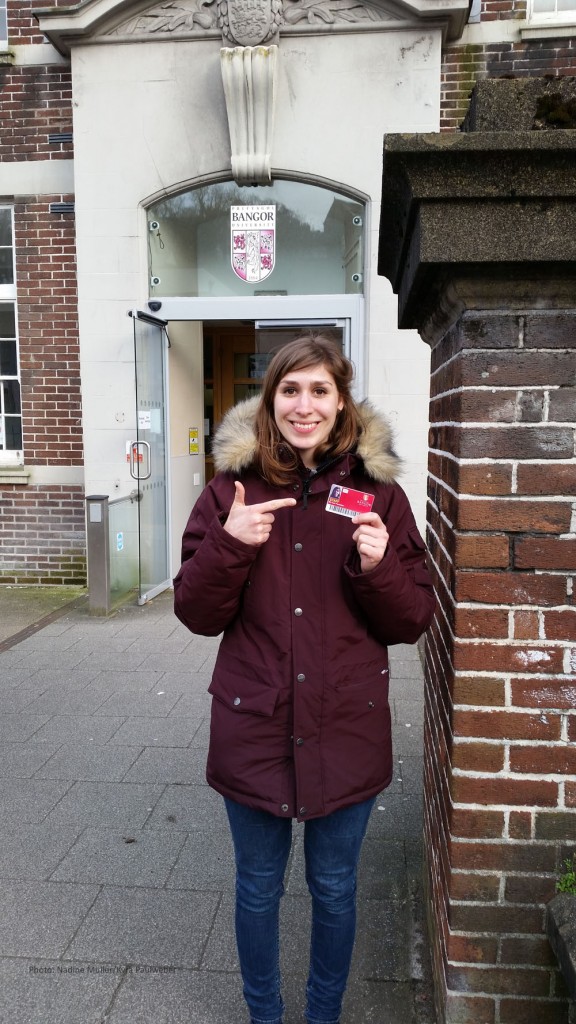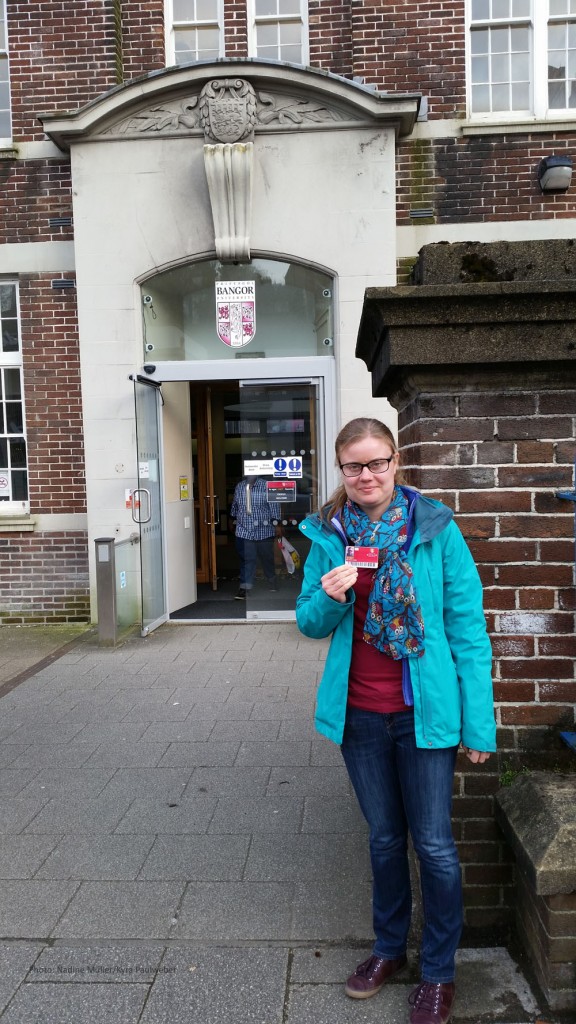Our GAME journey, which started with an introductory course in Kiel, Germany, in March led us, Kyra and Nadine, to the small but beautiful Wales. After we started in the early-morning hours in Kiel, our train trip took us to Hamburg, Cologne, Brussels, London and finally to Bangor – or Gwynedd in Welsh. Not only the Welsh language is particular, but we also had to familiarise ourselves with the left-oriented car of our landlord Wil, who drove us to our new home in Menai Bridge in the middle of the night.
Erwyn – that’s the name of our new home for the next six months. It is located in a small street of the small town of Menai Bridge – or Porthaethwy. Even if you do not know Menai Bridge, you probably have heard about its very famous neighbour: Llanfairpwllgwyngyllgogerychwyrndrobwllllantysiliogogogoch. But back to our town: Here you can also find the School of Ocean Sciences, which is well-known for its marine science curriculum and which belongs to the leading marine research institutions in Europe. Consequently, it is certainly a good opportunity and decision to go there to have an inspiring experience that is even beneficial for your future life and career. The university campus is also the place where the Welsh branch of the 14th GAME project will take place and will continue until September. Since our supervisor Andrew Davies and the other staff members are already familiar with the GAME programme and its time constraints, it was easy to plan and discuss the upcoming experiment with them. They gave us some useful guidelines and helped us to organize and plan our work during the following months. Furthermore, some materials and equipment was left from the previous GAME teams, which we could use for preparing our experiment. Thus, we could start early and test different constructions for our first set-up without spending much money.
One day after our arrival, we got a warm welcome and coffee (“don’t miss the coffee break” at 10:30 a.m.) from the whole staff. Furthermore, during the first week our supervisor Andrew Davies and our co-supervisor Coleen Suckling showed us the entire School of Ocean Sciences and introduced us to staff members who will probably provide us helpful support during the next months. As already stated the coffee break is eventually the most important time to get in contact with other staff or students to discuss problems and exchange experiences. It is therefore a crucial event that we try not to miss. Finally, we will be working in a temperature controlled room, which is very important for our experiment, because we need a constant background temperature regime as the basis for our treatments. With this, we can adjust and stabilise our further temperature levels precisely. We also have our own office with an adjacent workshop where we can prepare and build our set-up. Finally, we are now proud owners of staff-ID-cards and pertain officially to the School of Ocean Sciences. Due to this, we have access to the premises of the university and can get in outside the business hours. This is a very important for us, because we need to check for the well-being of our test organisms very early in the morning and also late in the evening.
Later during the first week we visited Bangor – the city of Gwynedd, which is also nice in daylight because the first time we arrived it was dark night. One of the most popular constructions here in Menai Bridge is the Suspension Bridge which connects the Isle of Anglesey with the mainland – and therefore with the rest of the world. The bridge is very impressive and also nicely illuminated by night.
Here you can find the campus of Bangor University, its faculties, the library, the brand-new Pontio building, a Performing Arts and Innovation Centre and other associated buildings. Bangor is a true university city with many students and student departments, which are spread over the whole city. It is very obvious that there are a lot of young people and students in this area. Here we also met many exchange and PhD students who come from other countries. That makes Menai Bridge and Bangor places of many different cultures and diverse people.
Next to a small shopping mile, there are also a lot of supermarkets in Bangor … and even the German companies Aldi and Lidl have reached this remote area of the British Isles. This is good for us, because the living and the rent are more expensive here than in Germany. But there are not only shops: In Wales you can find many small pubs and nice cafes where you can enjoy a drink and rest for a while. Our landlord Wil invited us for a lunch in the Blue Sky, which is an insider tip café near to the shopping street, where you certainly have to go when you come here.

Our landlord invited us to a nice cup of coffee and delicious and real British cookies at the Blue’s sky.
But we are not only relaxing and shopping! During the last weeks, we were busy with setting up our pilot study. In the GAME project of this year, the teams want to investigate the possible interactions between microplastics and heat stress on benthic filter feeders. In our case this will be the blue mussel Mytilus edulis and the Pacific oyster Crassostrea gigas, which are both common species in the Menai Strait.
Together with Berwyn, a technician of the School of Ocean Sciences, we went to collect our test organisms, not only from a nearby beach, but also from a local oyster farm that is about 8 miles from Menai Bridge. At this location we also deployed a temperature logger, which will collect data about the surface temperature in the Menai Strait until the end of our stay. By this we want to verify whether the ambient water temperature we are using for our experiment matches with the ambient summer temperature in the Menai Strait.
And Gwyn, also a technician and “master of the algae”, helps us to feed our hungry mussels. He supports us by answering questions about the amount to feed, which unicellular algal species to feed and how to handle the algae. We have now decided to use a mixture of two algae species to be able to guarantee a constant feeding in the case that one algal population collapses. Additionally, we have to find out which amount we want to feed to our mussels. For this, we need to quantify the amount of algae cells that is in a certain volume of water and this is something we have to do with a microscope. This took us some hours because algae cells are very small.

Getting our algae species from Gwyn and Nadine is quantifying the amount of algal cells in both species.
For our pilot study, we are using three water baths loaded with a total of 30 mussels – each water bath has 10 bottles and each bottle has one mussel inside. But before we could start the pilot study, we had to build the set-up, acclimatise the mussels and incubate the microplastic powder in seawater. By doing the latter, we want additives to leach and want the PVC particles to be covered by a biofilm, which could make them more attractive for the mussels.
During our pilot study, we want to apply the highest aspired temperature and microplastic concentration levels to check whether all of our mussels stay alive under these conditions. This is important information for the main experiment, because we want to avoid high mortality rates among the test organisms. Furthermore, we want to examine whether our set-up and the methods are working properly. But there is something we already recognized: Even if our set-up will be ready and the mussels will be acclimatized, there will still be difficulties which need to be solved. This is an everlasting process which familiarises one with scientific work and improves one’s way of thinking.
In our case, for instance, the air supply is very difficult to adjust, because we only have one air tube to aerate all experimental units. More than this, this air supply will also be used by other students in the following months, what is why we probably need to buy more compressors – not only to guarantee constant air supply, but also to provide a sufficient amount of oxygen for all of our mussels. So, for the coming weeks thinking and finding solutions will be a daily companions, which will make us very creative and innovative. In such a situation it is very helpful if you have a team partner or other people to talk to, because by this you get new ideas and can broaden your mind.
So, there is a lot to do until we reach the end of our visit in Wales, but we hope that we will also have time to explore the numerous facets of this part of the United Kingdom.













